
Who wouldn't enjoy the opportunity to change all the things about your life that you most yearn to change?
This is the question the designers of Second Life had in mind when they built their successful massively-multiplayer online world. Second Life is not premised upon the completion of quests, doesn't require you to have a job, doesn't demand that you defeat any alien races or slay any dragons. The whole idea of Second Life is that you have, well - a second life in all of its minutiae. Starting with the creation of a new you, the Second Life world offers opportunities for the designing and construction of virtual clothing lines, virtual cars and yachts, and even virtual villas. There's been loads of hype, so much so, that celebrities make appearances, and big business has taken note.
For all the grand dreams of what life could be in Second Life (SL), this metaverse, as it's called, is decidedly more geared towards the exploration of post-silicon body modifications than the possibilities of spatial experience free of gravity, budget, and all those persnickety details. When it comes down to it, from an architectural perspective, Second Life just sort of replicates suburbia. In a universe built from free and easily manipulated virtual building units, there is a surprising lack of interesting work going on. Evidence, perhaps, that spatial banality is not just a symptom of something larger, but an affliction in and of itself.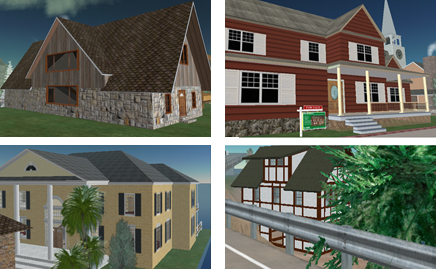
Typical private houses owned by SL residents.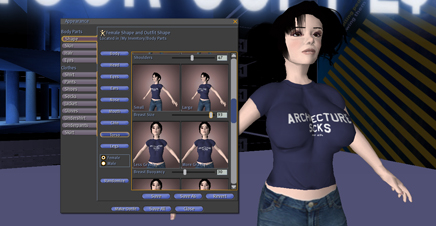 Avatarchitecture.
Avatarchitecture.
As SL gains in popularity, there have been a few experiments which propose interesting trajectories for the online universe as a productive tool. Near LaGuardia Airport, a real world park is slated to open in the near future. Named quaintly Landing Lights Park , it sounds like it could one-day be that clearing where you lie on your back in the grass to catch views of the jets coming and going. What makes Landing Lights Park interesting is that the borough of Queens bypassed community design meetings, and saved on landscape architecture costs by inviting neighborhood residents to design their park from within Second Life. It's a little optimistic to expect the community would be moved to register, create avatars and learn to navigate the site in order to participate in the planning process. But even given this Build It And They Will Come premise, the design process itself raised some alarms. In the virtual-meeting transcript, the planner explained, "So what we've done is come up with a list of common items that are usually included with parks." He goes on, "We call these items "doodads." Each doodad is a 5:1 scale model of common things - a picnic bench, a walkway, a basketball court." All that work just to hand the community a catalogue of parts? Markers and write-wipe boards are starting to sound democratic ...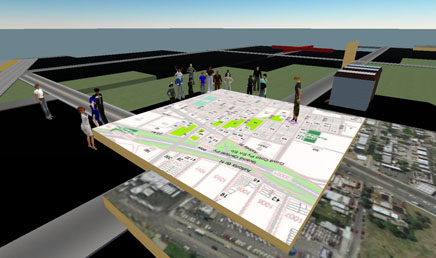
Archived from the Landing Lights Planning Meeting.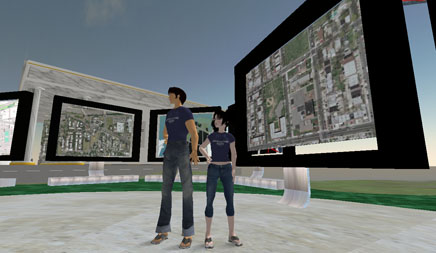
Landing Lights Park, at New York Law School's "Democracy Island."
But that "catalogue" mentality prevails in SL. It's as if when confronted with the 3-dimensional graphic manifestation of the infiniteness of the virtual universe , people immediately feel the need to fill it with things. So they purchase land, build (or purchase) houses, and fill it with furniture and objects. These homes sit like odd little dollhouses, physically irrelevant and structurally absent. After passing through the abandoned planning forum of Landing Lights Park, we visited a showroom of "prefab architecture" by a designer who unapologetically named his avatar ... um, "Rem Koolhaas." Rem makes his living (in RL) designing homes for avatars (in SL).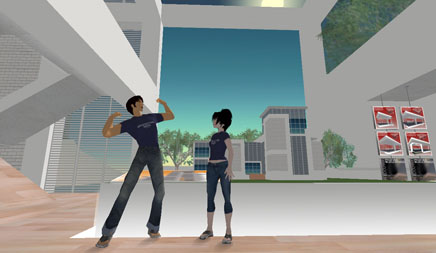
The pre-fab architecture-showroom of Rem Koolhaas. The other Rem Koolhaas.
When exploring the metaverse to find examples of these and other prefabs 'out in the wild' one slowly realizes that the main thing which is missing from SL is any sense of urbanism. There are moments of public space where piles of avatars meet up with one another, but opportunities to traverse from one defined place to another are rare. Why walk when you can teleport -- the primary means of navigation in SL? With the combination of jump-cut transportation and avatars which are overwhelmingly more interesting than the architecture, Second Life presents the ultimate indictment of public space: why shape places when it's all about the people, anyway?
Yet we can't help but feel slighted by the ease of movement in the metaverse. By taking too many liberties with the metaphor of an alternate life, SL fails to provide enough grit or resistance that gives RL genuine character. Other games transform some of the things we consider boring in RL into fantastic tasks in the game world. This is actually the goal and essence of gaming, one imagines: that through play we transmogrify casual into meaningful and fun into productive. Nintendo's Zelda: Ocarina of Time famously introduced a horse into the quest-game genre and provided a large world requiring you to traverse it. Here a sense of scale is introduced by the artificially short day cycle and as your character rides his horse across the map you experience sunset, a moon-lit sky, and sunrise which give the world a certain legitimacy. Games like Crazy Taxi , where you pick up and deliver passengers in a fictional city, or even the infamous Grand Theft Auto build their entire premise on the incidental experiences between point A and point B. Not to sound like a virtual Jane Jacobs, but by actively moving through these worlds we begin to understand the nuance of character of the different parts of the map and have a richer experience because of it.
What Second Life may lack in urban experience it has already, spontaneously developed in economy. With the rise of harvesting enclaves in China and the growing popularity of SL, individuals have been filling their real-life wallets with the fruits of their online labors for some time now. With the ability to aggregate geometry from small units and texture map these forms with any image you choose (not to mention the freedom from the typical constraints of the physical world), the possibilities within Second Life should present a real opportunity for new creations. Compared to other online worlds like World of Warcraft , what makes the economy of SL interesting is that it's built upon the sale of wholly user-designed content. That is, there's not harvesting or other tasks to earn you money. All bank is the direct result of your creative efforts. Indeed, with all the constraints of 'real life' and the overhead of 'real buildings' removed, SL is a utopia in the waiting. Or maybe in peril... like most utopias, it is currently threatened by the all-encompassing allure of shopping.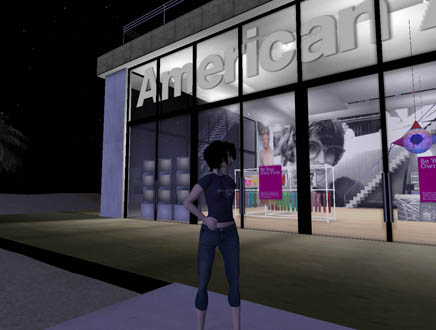
The Second Life HQ of American Apparel, where you can purchase gold lame hot-pants and leg warmers for your avatar.
But there is some hope. Last year, 4th year students of architecture at Royal Institute of Technology, Stockholm created LOL Architects , the world's largest virtual architecture office. With the aid of the 3D modeling tools bundled into the software of Second Life, the class set out to formulate the limitations and potentials for the production of architecture in a world where the boundaries between representation and reality are blurred. "The representation of objects as we see them and their measured description, two tasks that are conventionally distinguished in architectural drawing, will be shown to have been unwittingly, and in many respects, mutually determined and transformed." At this point we ended our tour of the SL metaverse, and Heather Ring sat down (virtually, of course) with Tor Lindstrand, RITS professor and founder of LOL. His research deals with performance, architecture and networks, offline and on. Much of his work is explored through International Festival , "a long-term project that operates between architecture and performance, emphasizing the performative potentiality of space and relations." This past semester, he taught a very-offline course called Cities are Made Of This , which concluded with a couple of built temporary projects in Tensta. But this semester, there will be a new set of student inductees joining LOL Architects, so we decided to meet in their Second Life headquarters: also known as, "The Office."

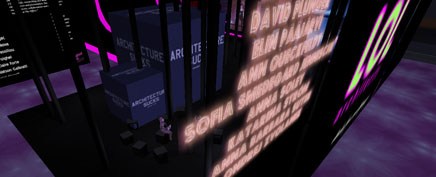
Me: i'm looking for tor?
Kapital Metropolitan: hi heather - i'm tor. good to finally meet you.
Me: oh! i didn't realize you were a girl -- i thought tor was a male name!
Kapital Metropolitan: ah! well, in second life i am a girl.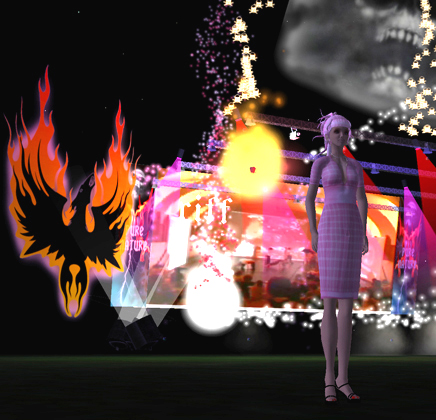
Me: ok, lets talk architecture.
Me : i cant get my little guy to sit down
[Wheel Fizz is in the The Office.]
Kapital Metropolitan: one thing i think its interesting to see what spaces or places in here become successful or most visited.
Me: ok, are you ready to begin?
Me: oops. what does make a good public space in second life?
Kapital Metropolitan: well, they all share more ideas about social activity than aesthetic quality. avatars attract avatars, so it's more about marketing -- but then there are spaces where people get married, spaces for rock concerts, events. so the visible architecture gets subordinated to a social network.
[Wheel Fizz has left the The Office.]
Me: how do you move your camera?
Kapital Metropolitan: press alt
Me: oh man, my camera has left the building. wheres my camera?
Kapital Metropolitan: i don't know --
Me: i think i screwed up my camera.
Me: i'm staring into the purple abyss!!!!!!!!!!
Me: are you there?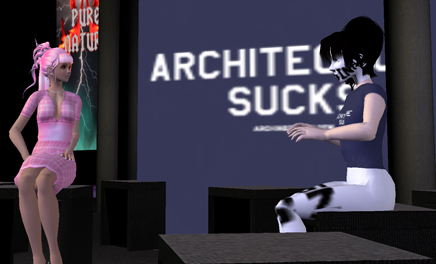
One of the most surreal things about Second Life is that when you chat, your avatar's hands perform a typing gesture, referencing your real-life body. In some strange technical glitch, I have no idea why there's writing all over my avatar's face or what -- in true Archinect form -- happened to her pants.
It was clear this wasn't working, so we decided to move the conversation to a good old-fashioned chatroom.
heatherring: Tor, i feel like the conversation we had in Second Life was sort of a disaster.
Tor_Lindstrand: Yes.
heatherring: I was talking over you, there was a time lapse, there wasn't a good rhythm, I was very distracted by the cameras and the space. Our communication felt stilted and slow, and all this seems relevant to the potentials of utilizing Second Life as a space for artistic collaboration.
Tor_Lindstrand: Very much so. I guess it's the same thing as with any communication tool. We have to adapt to the new technology. Like with email, people will find new, often quicker ways of talking. The question is how much time you are willing to spend on developing these skills. If overcoming that threshold of communication is too difficult, the population of Second Life becomes a very specific one, homogeneous. The broader audience will be pushed aside.
heatherring: And it seems to require the same commitment for learning scripts whether you're changing your appearance, choreographing the way you move/interact/present yourself, or whether you're building "architecture."
Tor_Lindstrand: This is interesting, because in life the borders between the different layers of our private space are clearly defined: clothes, apartment, house, city, country, continent. But in Second Life these borders are blurred, diffuse and this is something that is so elaborated. I think people spend a lot more time and economy on their avatars then they do on architecture or building.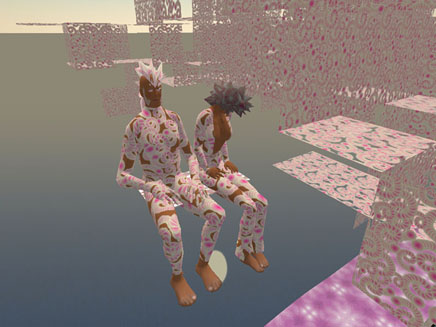
 Rodolphe Albert & Bengt-Olov Berggren produced tileable textures, and projected the pattern on themselves (who were then projected into SL).
Rodolphe Albert & Bengt-Olov Berggren produced tileable textures, and projected the pattern on themselves (who were then projected into SL).
heatherring: But when you look at most of the architecture in SL, it really is remarkable how conservative and boring it is.
Tor_Lindstrand: I was thinking about where this comes from a lot in the beginning: if you can do whatever you want, why it becomes so totally predictable. Then I saw an episode of MTV Cribs and understood that if people have all the freedom and money and can do whatever they like, this is what they do. I thought that was kind of liberating, because I realized that I can stop concerning myself with trying to understand what people want.
heatherring: But wait -- do you think the architecture of Second Life indicates "what people want" -- or do you think it just indicates the limits of their imaginations?
Tor_Lindstrand: I think that we live in a world where the production of desire has been completely overtaken by market economy, and this is manifested so much in Second Life. I guess it shows that the major influence in thinking about architecture today is more through other media than through architecture itself. Rather than spatial experiences, it is much more about images, television, movies, games. I'm interested in how the image of architecture is so dominant in platforms like Second Life and how this relates to how the image is becoming more and more dominant in contemporary architecture, how we consume architecture as much through Hollywood, expensive coffee table books and tourist information as we do through spatial experiences.
Annika Hogsander's process.
Tor_Lindstrand: When I first started teaching at the advanced level, we used game engines as 3D modeling tools. The way it worked was: when you "played" the architecture, you were locked into your body -- a first-person perspective.
heatherring: Here there is sort of this double-disembodiment: one between yourself and your avatar, and the second, between the avatar and the world it inhabits.
Tor_Lindstrand: Well, this I think is partly because of how they are constructed. The avatar has a physical representation, but can also fly and look around in very strange ways. 360-vision. So there is a disconnect between how we look and what we are. And this poses enormous problems when it comes to architecture. Because it is not until we fully understand this new body that we can produce anything that is really interesting. When the architecture becomes more specific in relation to how we experience things then it will evolve quickly. But this will take time, we really have to rethink everything we know of architecture, which is so grounded in how we are in this world and the physical limitations of it.
heatherring: It sounds like a sci-fi scenario: What would our cities look like if a) we couldn't walk and talk at the same time and b) we had total mobility / fly-throughs in vision even as we were standing still?
Tor_Lindstrand: Precisely, and in science-fiction films it always look really silly. But the difference is that in Second Life there are already certain properties, things work in certain ways and when someone starts to develop that, then maybe we will see a completely new kind of architecture. I am sure this will happen, maybe not now or in Second Life, but in some future platform. We could start modelling a platform as similar as possible to our own world, but then we miss the opportunity to enter new ways of thinking and being architecture.
heatherring: But what is the goal? To understand how to design for this physical scenario in this virtual world, or to bring something back to our own world? Or do you see a cyborgian future where these are too intertwined to separate?
Tor_Lindstrand: What we see now is only the beginning -- I think the web will look something like Second Life or at least it will be a 3D space of some sort in a near future. If you think about it, Everquest , which was the first really popular online world, was released in 1999. And no one thought Second Life would have 2 million inhabitants a year ago, or that youtube would be sold for 1.65 billion dollars. So whether we like it or not, we will live in a world where these platforms exist, with or without architects. So I guess we have to prepare, because this world is coming.
heatherring: Perhaps understanding the relationship of the avatar's body to Second Life's world is not so different from understanding how our own body/space relationships are shifting as we wear these technological appendages. Like the dislocation of walking down the street with a cell phone. Maybe one day we'll all be walking around with some device (probably a cell phone feature) that gives us 360-vision ourselves, just like the avatars.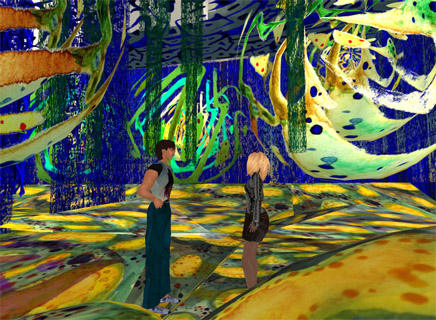
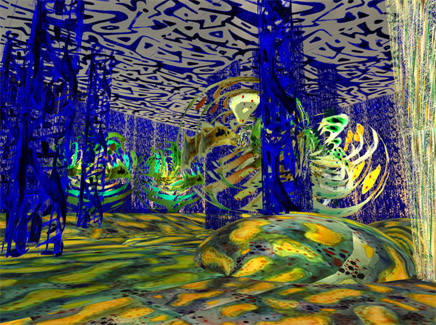
Askel Grip's watercolor mappings. (via)
heatherring: I read about this architect that designed a real-world house and built it in Second Life so his clients could walk through it .
Tor_Lindstrand: Ah, ok. But I have never thought of Second Life as a new cool tool to develop architecture as representation but rather to discuss the underlying structures of architectural production. For me it is all about how I can re-think social structures, work, life, networks. Architecture, and especially architectural educations are very bad in having a critical view towards the tools they use. There are many architects that just specialize in programs or methods, and this is the threat, because it pushes architecture into representation and makes it introverted and stale.
heatherring: How does working with these virtual-platforms help break down those conventions?
Tor_Lindstrand: Well, virtual platforms, as such, are not breaking down any conventions, but they can help us to see things differently. Maybe even think differently. So it's not so much about changing things (doing the opposite), which is more like producing an image in a mirror while continuing to do the same. It is much more about changing the way things change. I think for instance, excel has had a greater impact on contemporary architecture than Rem Koolhaas, Zaha Hadid and Frank O. Gehry have managed together. When economy and architectural concepts become increasingly intertwined and transparent then the traditional role of the architect transforms and opens up decision making for professions traditionally remote from the design process.
-------------------
heatherring: I think your student Magnus Nilsson has hit on something with his YURT++. As mobile housing, it's so resourceful both in terms of economy and social-interactions. Instead of buying fixed property and trying to convince other avatars to visit it, why not have your house/identity an extension of your skin, and wear it into any public space?
Tor_Lindstrand: In Second Life, you can measure the popularity of sites by the clustering of people. With Magnus' project, popularity can be mobile, turning architecture into something that you wear.

Magnus Nilsson's YURT++.
Tor_Lindstrand: I think Magnus' project and Alpar Asztalos' have that in common, that they point towards architecture as something mobile and something you perform - rather than stable structures.
heatherring: Alpar's 3D Graffiti is brilliant -- not just for its mischief and street-art sensibility, but also because it utilizes the social properties of SL as a form of research and documentation on ideas of property ownership.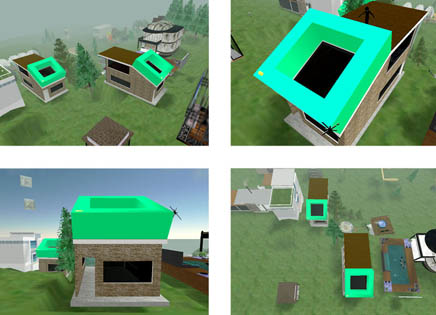
IM: Zulan Luan: What are you doing on my property? / Raplaa Lazarno: 3d graffiti! :) / Zulan Luan: For what? / Raplaa Lazarno: experiment! / Zulan Luan: You are violating on my property. / Raplaa Lazarno: sorry! :) / Zulan Luan: You are going get reported right now. / Zulan Luan: That's not acceptable. / Raplaa Lazarno: OK! / Zulan Luan: Done reported.
Second Life: Your object '3D GRAFFITI' has been returned to your inventory lost and found folder from parcel 'Zoning violation - terrain reset.' at Ibiza 134, 175.
(the same hour)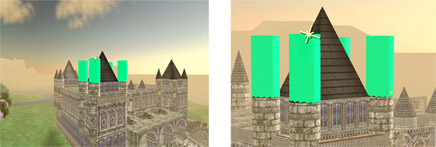
IM: MIkeypookins Martin: retard
Second Life:Your object '3D GRAFFITI' has been returned to your inventory lost and found folder by 'MIkeypookins Martin' from parcel 'Alexia's and Mikey's' at Malmoe 126, 195.
(the same day)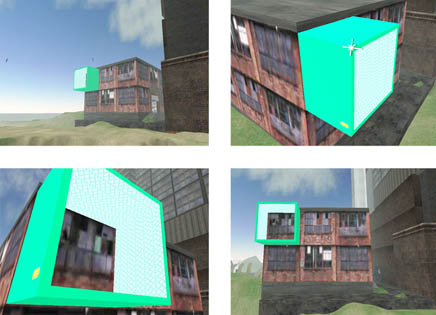
Second Life: Your object '3D GRAFFITI' has been returned to your inventory lost and found folder from parcel 'Funky Tony ' at Grignano 93, 198.
(the same day)
heatherring: Erik Andren's project looks interesting too -- using scripting to make some kind of intuitive architecture, where rooms disappear when you leave them.
Tor_Lindstrand: It's a moveable and transforming structure -- a great example of temporary, instant-architecture for Second Life.
Erik Andren's transforming structure.
heatherring: I also really liked the idea for Elin Paajarvi's Cemetery for Lost Avatars -- a place to mourn the losses of a friend that never logged back on.
Tor_Lindstrand: The idea for the project came when she started to compare the total amount of residents and the ones actually online. There are huge numbers who register and never return. It's so easy to become a resident in Second Life but impossible to unregister your account. I think the official figures are something like only 10% ever come back a second time. So the figure 2.3 million is more like 200 - 300,000 -- which means there are 2 million non-active Second Life avatars. The need for graveyards is enormous.
heatherring: Well, that would be more true if your avatar's body was left wherever you logged off -- even if you weren't online. Just slouched over. That would be a much more interesting phenomena -- to have the 2 million bodies taking up actual space in this world. You'd really know which places are dead by how many limp bodies are there, waiting to be re-animated.
Tor_Lindstrand: That would be awesome, but I guess not very good business for Linden Lab since they want to sell Second Life as a place that lives and not full of corpses. I am totally with you, piles of dead avatars would be so good. Return of the living dead Extravaganza.
Elin Paajarvi's Public Memorial Place.
heatherring: So how would you characterize LOL architects' approach to virtual architecture? Could you talk about the processes and intentions of the class?
Tor_Lindstrand: Well, first of all - we have never taken any special interest in virtual architecture. I think this divide between virtual and real is very problematic - it's something that we have adopted from literature, especially science-fiction, this idea of a parallel universe. For me it is all about architecture. I think there is a much greater difference between how I work as an architect compared to how Mies van der Rohe worked in the early 30's, than there is between real and virtual architecture today. So as for the processes and ideas of the class last spring, we just introduced a field and researched potentialities through practical and theoretical work. It was new territory for me as a teacher as well. I didn't go in with a clear idea of what it was, leaving the students only have to fill it in, connect the dots. I do not work like that, and I am not so convinced of polished methodolgies and clear-cut modes of production.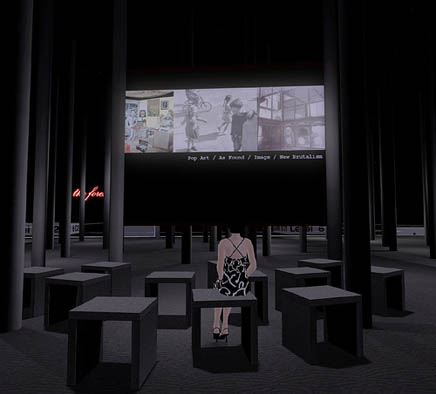
The Office.
heatherring: How will this be elaborated next semester ?
Tor_Lindstrand: This semester will be different, more about social networks . We are using The Office as a sort of open university, connecting schools and organisations to share the space with us. We will be collaborating with the Royal Institute of Technology Stockholm , Piet Zwart Institute in Rotterdam, Technical University in Graz, University of Linkoping, Supermarit , Van Abbe Museum Eindhoven and International Festival . We are also discussing with Pirate Bay about setting up an office on copyright issues. And hopefully some sort of collaboration with Archinect . It's interesting to push the social sides of the platform. It's all about world domination, and we are aiming to be the largest architectural office in the world.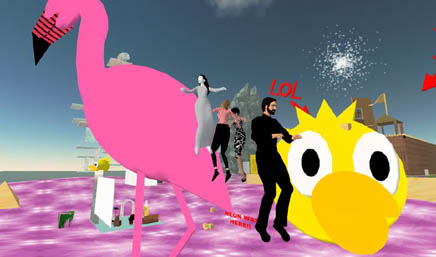
INVITATION: LOL Architects have invited the Archinect community to be in-world critics at their reviews. There will be Tor's class from Stolkholm and a class in Rotterdam taught by STEALTH , among others. If you're interested, let us know , and we'll keep you updated.
Creative Commons License
This work is licensed under a Creative Commons License .
/Creative Commons License
29 Comments
where are the LESS tshirts in second lifez?
seems like i talked all about this already...
This is fascinating and terrifying.
So whether we like it or not, we will live in a world where these platforms exist, with or without architects. So I guess we have to prepare, because this world is coming. - Tor
It seems "this world" is even poised to overtake the physical world (RL) economically, as people are making a livelihood in Second Life. But as someone who makes her living in the physical world, and is deeply emotionally entrenched in the physical world, I wonder how it really will affect my livelihood on the coming two decades. I am not good at forecasting, so I worry.
The lion's share of my exposure to SL has been through this article and other bits on Archinect. I wonder about the experience of "watching" your avatar, not having (not exlusively, certainly) the real world experience of inhabiting your body moving through space rather than watching your body, from some other point, move through space. It seems like that could lead to a disjunction in accepting consequences. However, that is the role of the architect, right? To simultaneously experience the building from the first-person-walking view and the godlike all-knowing view?
I've never, ever found a computer game of any type - and kids, this goes back to the first generation of Pong that I played on a friend's TV in his rec room - that could keep me interested for more than a few minutes. Yet I can spend hours upon hours on Archinect, where we have (I imagine) a very similar type of interaction as the residents of SL do, minus the component of spatial representation. One would think we architects would be clamoring for that - or on the other hand, would we all just argue about it and want to redesign one another's renovations to the image?
Totally amazing article, Heather, thank you for doing it - quite a bit of work went into this!
LB, I agree with you, I am a bit scared of this new digital world.
Like you I dont play video games, they really bore me, so I may be wayyyy off on my views about all this. Having said all that, I got thinking after posting this blog entry and found that I, and others, had completely overlooked ethical issues. What happens when we start equating the real and digital worlds? As Sorkin points out we have many important issues in RL to tackle, and I am afraid that people that increasingly live in a SL will become highly unsensitized to these existing problems and the future effects of their actions in the RL. For example, once more and more suburbs with mcmansions (from the images above) are designed in the SL, aren't more people in more places going to want them in the RL?
I still think that it would be a great place to experiment though. I think that what Erik Andren's transforming structure is doing is pretty amazing. There is no way that you will confuse worlds in that project, and I can see how one can learn a lot from exercises like that. Sadly, I have a feeling that SL will see more mcmansions and less transforming structures.
The taking over and possible future manipulation of these worlds by corporations is a bit scary too. I have a feeling that all these things are exciting right now, but in 10 years they will be way too controlled to allow you to actually do anything of value except buy nikes go to american apparel, etc... conditioning behaviors.
interesting article...i find the entire set up of sl more of a performance piece than a substitute for reality and so it doesn't bother/excite me so much...yet.
do like the artwork/activities archived above. fun.
Right on, +q, re: the ethical dilemmas. The article mentions someone calling themselves "Rem Koolhaas" and designing houses for people under that name - it's a tiny and humorous ethical breach, but nonetheless it points to a bigger question. I think that question plays into the avatar and the fact that you can watch what happens to that "person" without inhabiting that body - you won't feel the blow, so why worry about if it will hurt?
Anyone who reads [url=http://www.thestranger.com/seattle/SavageLove[/url] Savage Love saw that this week's column includes a woman who was duped online by a guy who eventually admitted he didn't ever want to meet her - he just enjoyed stringing women along, the thrill of the "pursuit", AKA toying with people. I think it's harder to do that to someone's physical person!
On another of your comments, it seems SL is reflecting the real world of the internet, where 15 years ago it was an anything-goes frontier and now it's largely - not entirely by any means, but largely - populated with corporations.
i am homeless in SL. but if somebody wants to donate a piece of land to me, i'll build the barcelona pavillion on it and you can all stay in. my avatar is faceless right now and it is cold outside. i noticed some rich fuckers with full membership to SL has several plots butt jointed and there are some islands for sale. i wonder how much land heather ring owns or given by the owners. but doesn't look like i'll see her on my side of railroad tracks. i spent last night sleeping next to bunch of dead avatars in the graveyard where people just died from SL hardship. well like i said i am homeless at the moment and i don't know how much more i can go like this without the full membership.
Eye Beam (free last name driven avatar nahme)(yes i am german)
super interesting article! so many potential tangents!
although it may not be a substitute for RL (jump), the characteristics of the SL environment (when left to the average individual) are astonishingly banal, which does, unfortunately, reflect RL... and with this reinforcement comes, at least in part, +q's concern. boring gives birth to boring, propagates boring, more boring...
props to Tor and his/her students for their imaginative responses to SL.
did thread central move to SL?
In light of the comments above, if I were to go into business in Second Life, I would become a green-roof designer. If the image of architecture is so powerful that it might influence collective desires and propogate more of the same, than the image of the green roof might feed into the fantasy of the perfect house, the perfect life.
Of course, "sustainable architecture" in SL is an absurdity, but there's nothing inherently worse about an image of a McMansion than an image of something imaginative or responsive ... they are all just made of the same material: pixels. I actually think a green roof works the same way in real life too: it's one of the clearest representations of sustainable design. Visible from rooftops above, the swath of green might just be astroturf, but it's still the most literal image of green-design (it's green) that can be seen from all adjacent towers. In Second Life, the avatars can fly. Maybe they'll pass over a green roof and want to know where they can get one of their own!
(That said, I have absolutely no plans to go into business in SL.)
I think that's a brilliant business plan, though, Heather! And as in RL, it's all about building desire in people, right? So if you can make others see your green roof and desire one for themselves, either because it's a smart way to live OR becuase everyone else has one and they want to be cool, then there's your market.
And yes, as AP said: props to Tor's and students' work analyzing this "other" form of architecture and society. It is definitely worht analyzing.
this is a great feature. thank you.
With the combination of jump-cut transportation and avatars which are overwhelmingly more interesting than the architecture, Second Life presents the ultimate indictment of public space: why shape places when it's all about the people, anyway?
orhan you can buy a plot on ebay and some second life archinect dollars to spread around.
Ever hear of habbo hotel? Similar to SL (from what it sounds).. pretty much a virtual chat room. Users can buy items in their own room and sell services or furniture for haboo dollars. Now the thing that utterly confuses me about HH and SL.. why would someone pay for a virtual item? Why would someone use real physical dollars for virtual items? Don't get me wrong, I think SL has infinite potential in the investigations talked about here (with the ability to build with complete freedom).. but the idea of paying real money to build up a virtual life is downright scary. Are people really that upset with their real lives that they need to create a second one? I understand World of Warcraft and Everquest's goals-- the quest to complete a mission in a GAME. People reaching to complete a task, save the world, etc, etc. But when the goal is to build a better person than the one in front of the computer screen, why!?
Pretty crazy, huh? The first link, of the virtual clothing lines is the most strange of all to me: the shopping blog is so engaging to read, and they're just shopping for an image! It's funny, because when Bryan and I were trying to position our avatars for a good camera shot, it kept reminding me of of my very typical college experimentation with ... Barbie Doll Video Art.
what i think is missing, from what i've heard of second life, is entropy: any sense that things might age, degrade, weather, die, evolve. my project in tor's studio would be to figure out how to introduce some sort of plug-in to the system that would begin to age things, make them less bright, a little dirty, add some funk to the fauxburbs.
this is only one aspect of an even bigger issue. aging, weathering, etc feed into my desire for this new thing to be able to inform through sensations of some sort. cold/hot, soft/hard, smooth/textured are all missing. how bleak. but then new residential construction is often as sensationless...
... though maybe instead of aging through the representation of weathering, the homes might age the way an image would hypothetically age: pixelates, loses resolution, colors fade. soon all the artists will be moving into the blurry homes, causing a wave of gentrification, until some blurry homes get erased to make way for high resolution homes ...
yes! what if you could track "outside" pixels in the house?
or if the gutters fell off if you failed to clean them, they got clogged, overfilled, etc.?
what if your avatar had to rake leaves or mow the lawn?
then it would be simlife..
people want the good life without any of the work (hence their second life)
Would our SL be satisfying in a way that makes us leave our challenges in real life ??
"In SL i met a girl,have a good career,i am popular,," so i dont need all this in RL..
what i wanna say, would SL compensate for RL?
Would we put all our energy in imagination, and live in misery in real??
Well, I work alone, and because I have "coworkers" on Archinect I feel less of a need for them in real life.
maybe it's time to get rid of my internet connection
goes second life.
As seen in the News Section:
http://archinect.com/news/article.php?id=53054_0_24_0_C
digital resistance:
http://slla.blogspot.com/
digital satire:
http://www.getafirstlife.com/
There are now hundreds of licenced Architects in Second Life experimenting with the medium. They all anticipate that the next step will be for BIM & CADD and the web to become fully 3D real time. In Second life there are already drag and drop data loaded and scripted objects provided by manufacturers like Steelcase and Herman Miller. Walk through your buildings with your clients who are 3000 mile away. Make changes on the fly. You can do that now, it is primitive but so was the Internet 10 years ago.
Read about MIT, Stanford, Harvard, Princeton all working there along with about 400 other colleges and universities around the world. Did you miss the fact that the Chinese have just pledged a billion dollars to be THE major player in this new world of the 3D internet and marketplace.
Take a look at arcspace.com/sl, watch all the trade press, and visit companies like Autodesk and IBM in Second life to see just how Second Life and Real Life are being integrated.
You can go back to drafting on paper if you wish, or stay with drafting with your mouse all day. Sorry, It is said: "use it or loss it". Architects have lost more of their profession to others and paid less then any other profession. Now the title is used more by high paid software engineers then shall I now call you "building architects". Be scared and sarcastic if you want.
Read and follow a few links:
http://jeanricardbroek-architect.blogspot.com/
This is an interesting article and a very debatable one judging by all the interesting comments. Nevertheless, if this 'SL world' may potentially overtake the physical world, or result in ethical issues, as have been discussed, the possibilities of all this turning out the exact opposite should, logically, also exist. I'm not against anyone's views, since there are undoubtfully a lot of different opinions, but it would seem SL has nontheless been taken as and treated as just another online game to a fair share of the gaming community. You would find SL news, guides and other gaming information alongside any other computer games such as Everquest or Warcraft. And to make my point, you could see for yourselves at http://www.killerguides.com/guides/sl/guide/second-life/linden-dollars
or http://pc.gamezone.com/gamesell/p21217.htm I'd say how you see it depends person to person, but I am thoroughly enjoying SL and looking forwards to seeing how it will develop over the years.
read:
At the Art Positions fair in Miami in December, the Chinese experimental artist Cao Fei sold a work to a privatcollector for $100,000. It wasn’t a painting or a sculpture or one of the short videos that Ms. Cao, 30, is known for. Rather, all that money bought a piece of virtual real estate in the online world Second Life.
at: http://jeanricardbroek-architect.blogspot.com/2008/03/second-life-digital-design-competiton.html
or
"Troy, N.Y. – Today’s video games and online virtual worlds give users the freedom to create characters in the digital domain that look and seem more human than ever before. But despite having your hair, your height, and your hazel eyes, your avatar is still little more than just a pretty face.
A group of researchers from Rensselaer Polytechnic Institute is working to change that by engineering characters with the capacity to have beliefs and to reason about the beliefs of others. The characters will be able to predict and manipulate the behavior of even human players, with whom they will directly interact in the real, physical world, according to the team.
At a recent conference on artificial intelligence, the researchers unveiled the “embodiment” of their success to date: “Eddie,” a 4-year-old child in Second Life who can reason about his own beliefs to draw conclusions in a manner that matches human children his age.
Just a few other posts:
http://jeanricardbroek-architect.blogspot.com/2008/03/urban-reconstruction-and-modeling-for.html
http://jeanricardbroek-architect.blogspot.com/2008/03/bringing-second-life-to-life.html
http://jeanricardbroek-architect.blogspot.com/2008/03/national-academy-of-engineering-has.html
Enhance virtual reality
http://jeanricardbroek-architect.blogspot.com/2008/02/microsoft-acquires-caligari-for-virtual.html
This is no longer a game.
The article mentions an important point. Teleporting, rather than walking or flying, is defining aspect of Second Life. So one doesn't get the same feeling of the scale of the world, as when you drive through a city - passing many different buildings and places on the way to your destination. I don't think that can change very easily, unfortunately. But I have another idea that would be interesting to try and put into code.
What if, instead of the top-down map that SLURL gives us, we could build the same, but rendered at about 45 degrees down onto the islands? In SL, there is a bandwidth problem - you have to wait for a fairly long time for everything to load when you go to an island. So people do not go to as many as they would want. But if islands were caught onto small thumbnail images, they would load at 1 island per second, and it would be very interesting to explore - since you would be getting a view onto many islands quickly, from a vantage point similar to the in-world fully-zoomed out view.
Regarding the replication of real life architecture in SL, I think there should be a balance. Normal buildings are familiar to people, and that's very important. If they are in a place that they can't relate to at all, then it sort of loses its value to them. It feels odd. It might be interesting briefly, but people wouldn't be coming back to the same strange place many times.
On the other hand, if it's just a block office building, or even a standard house, then it's dull, and there is nothing to interest people either. So, a bit of both is good: some expected architectural and landscaping conventions to give it a sense of place, and at the same time something cool that you don't get in real life.
Maybe that's wrong, actually. You could go to either extreme, and still be a successful sim, or you can be anywhere along the scale from mundane-urban to wild-Salvador-Dali-like, and still be boring to users. There has got to be something that engages the people from when they first teleport in, and for as long as they stay on your parcel. Something like a central story, or an interesting mechanism powered by scripts, or things of that nature. Interactivity and the user making a difference to the sim is also important.
I think I could make that my first principle of designing in Second Life.
Evgeni
Author of Sketchlife, a SketchUp-based Second Life building tool
http://vrshed.com/sketchlife/
Block this user
Are you sure you want to block this user and hide all related comments throughout the site?
Archinect
This is your first comment on Archinect. Your comment will be visible once approved.